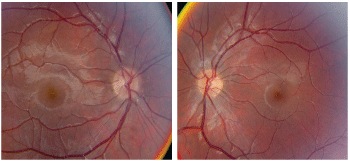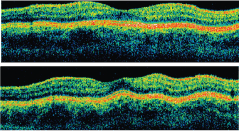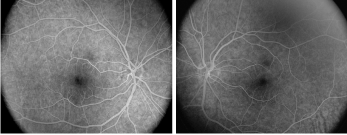 A 16-year-old white female presented for an evaluation of blurred vision in both eyes upon referral from an ophthalmologist. The patient reported that her vision had been impaired for about one year.
A 16-year-old white female presented for an evaluation of blurred vision in both eyes upon referral from an ophthalmologist. The patient reported that her vision had been impaired for about one year.
The patient initially presented to a different optometrist, who referred her to an ophthalmologist after he could not correct the problem. The ophthalmologist was also unable to correct her vision to 20/20, so he referred her to the Bascom Palmer Eye Institute for further evaluation. Her ocular and medical histories were unremarkable.
On examination, her best-corrected visual acuity measured 20/200 O.U. at distance and near. Confrontation visual fields were restricted 360 O.U. On threshold visual field testing, however, the right eye was essentially normal, but the left eye showed an inferior paracentral depression. Her pupils were equally round and reactive, with no afferent pupillary defect. Extraocular motility testing was normal. Her anterior segment examination was unremarkable.
The dilated fundus examination of each eye showed a small cup with good rim coloration and perfusion. Her vitreous was clear. The vessels were of normal caliber. Her maculae and periphery appeared normal O.U. (figures 1 and 2). Optical coherence tomography (OCT) (figures 3 and 4) and a fluorescein angiogram (FA) (figures 5 and 6) were also performed.

1,2. Fundus images of our patient (O.D. left, O.S. right). Is anything abnormal?

3,4. Optical coherence tomography of our patient"s right eye (top) and left eye (bottom) through the maculae.

5,6. Mid- to late fluorescein angiogram of our patient (O.D. left, O.S. right).
Take the Retina Quiz
1. What results do the OCT and FA yield?
a. The results of both exams are normal.
b. The results of the FA are normal, but the OCT shows subtle retinal thickening.
c. The results of the OCT are normal, but the FA shows quiet choroids.
d. The OCT shows loss of the photoreceptor elements, and the FA confirms this.
2. What additional testing would be most useful?
a. Color vision.
b. Electrodiagnostic Testing.
c. Magnetic resonance imaging.
d. No further testing is indicated.
3. What is the diagnosis?
a. Cone dystrophy.
b. Functional vision loss (FVL).
c. Stargardts macular dystrophy (SMD).
d. Occult retinal dystrophy.
4. What is the appropriate management strategy?
a. Genetic testing.
b. Reassurance.
c. Referral for a comprehensive psychiatric evaluation.
d. Referral for a low vision evaluation.
For answers, see below.
Discussion
Prior to presenting at Bascom Palmer, our patient had actually been seen by not just one, but two ophthalmologists for evaluation of her vision loss. A review of her records from both ophthalmologists was pretty consistent. One obtained an electroretinogram (ERG) and a pattern ERG, which were both normal. The other ophthalmologist performed magnetic resonance imaging, and it too was normal.
With this information in mind, we repeated the ERG and pattern ERG, and noted similar normal findings. A review of the FA and OCT also demonstrated completely normal findings. So, we referred the patient to the neuro-ophthalmology service for additional testing.
On color vision testing with Ishihara plates, the patient reported that she was only able to see parts of the colors on each plateeven with the test plates, which was peculiar. Additionally, on visual field testing at both one meter and four meters, the patient had nonexpanding, tubular fields.
Given these findings and the normal imaging testing, we concluded that the vision loss our patient had experienced was functional in nature. With further history, we were able to find out that her mom and dad were in the process of going through a very bitter divorce. To make matters worse, her younger sister recently attempted self-mutilation with a knife.
FVL occurs when a patient experiences a visual deficit without an organic or sensory basis. FVL is a diagnosis of exclusion, made only after organic pathology and sensory problems have been ruled out.1
This condition should not be confused with a patient who is malingering. A malingerer is a patient that intentionally reports false symptoms in pursuit of a goal. A notable example: a patient who fakes an injury in the hopes of
getting a financial windfall from a lawsuit. In contrast, the patient with FVL genuinely believes that the symptoms are real. These patients are usually under psychological distress.
There is also one other consideration: This patient may have Munchausen syndrome. Munchausen syndrome is also a psychological condition, but the patient intentionally produces or fabricates the symptoms for the sake of prolonging the role of being a patient. Patients are aware that they do not have a problem, but their motive is to receive attention.2
With unexplained vision loss, it can be difficult to decipher either the ultimate cause or true nature of the problem. Whatever the case, most similar conditions seem to have a psychological basis. As primary eye-care providers, some of us may feel ill equipped to handle and decipher these types of ailments.
As a clinician, you must still systematically work through the examination and perform the necessary ancillary tests to rule out any organic causes. Electrodiagnostic testing may be the most definitive way to rule out any occult retinal or organic conditions. As with any complicated case, the patient history can be critical in uncovering and/or explaining any potential psychosocial issues that could cause the otherwise unexplained vision loss.
Once you make a diagnosis of FVL, you can tell patients that no pathologic basis for the symptoms could be found. Do not say to the patient or family members that the symptoms are not real. In contrast, reassuring the patient and family that he or she will get better has been shown to be the most effective path to full visual recovery. While unnecessary in our patients case, a psychiatric evaluation may be helpful in certain instances.2
Our patient clearly had some psychosocial issues stemming from her parents divorce that were responsible for her vision loss. The situation also seemed to affect her sister, who was dealing with the divorce in a completely different, dysfunctional way. Once all these issues were revealed and the ancillary testing was completed, it became much easier to diagnose and understand the nature of what was going on with this family.
The patients mother and father were reassured that their daughter was fine and should expect a full recovery. Family counseling was also recommended.
Retina Quiz Answers: 1) a; 2) b; 3) b; 4) b.
1. Hoffman DF, Wilson R. Functional vision loss. J Am Optom Assoc 1994 Dec;65(12):835-44.
2. Villegas RB, Ilsen PF. Functional vision loss: A diagnosis of exclusion. Optometry 2007 Oct;78(10):523-33.

